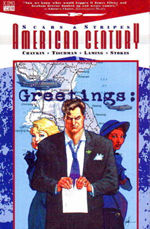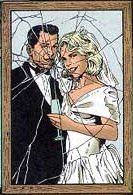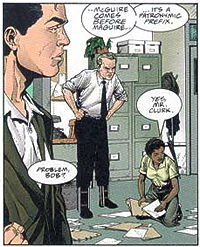>> Comment: Appointments With Disappointment
>> Comment: Accentuate The Positive?
More...

 Writers: Howard Chaykin & David Tischman
Writers: Howard Chaykin & David Tischman
Artist: Marc Laming
Colourist: Pam Rambo
Separator: Jamison
Letterer: Ken Bruzenak
Inker: John Stokes
Collecting AMERICAN CENTURY #1-4
Price: $8.95
Publisher: DC Vertigo
ISBN: 1563897911
I'm sure most men have, at some point, wondered what it'd be like to live in a porn film. When every rendezvous with a member of the opposite sex blossoms into a soft-focus shagging session. Well, imagine no more, for you have now stepped into Chaykin World.
In the summer of 1949, Harry Block becomes Harry Kraft, a small-time pilot and unhappily married man who fakes his own death and sets off on the great adventure. Arriving in Guatemala, he discovers a web of complex politics and a simmering cauldron of revolutionary fervour.
Whilst it could be said that Harry is the catalyst for change on a grand scale, it feels more like he drops into a tinderbox just before it ignites itself. Guatemala's heady mix of communists, CIA agents, double agents, revolutionaries and down-at-home normals is often hard to track.
Howard Chaykin and regular co-conspirator David Tischman have essentially created a boy's own adventure for men, stretching across American history, with the addition of artistic newcomer Marc Laming and long-time Vertigo veterans Pam Rambo, Jamison and Ken Bruzenak. Neatly divided into four-issue arcs, Vertigo took the wise decision to collect the first arc ASAP.
The first thing that stands out about AMERICAN CENTURY is that it does stand out. It's not traditional Vertigo by any stretch of the imagination, and should be applauded for it. It's a genre that we see little of in the comics field, but one that Chaykin seems quite at home with. The historic detail seems spotless and highly detailed. A little too detailed at times. At four issues, it feels two issues too short. It's a fascinating setting and one that deserves more space.
 If the intent is to evoke the pulp novels that obviously influenced Chaykin as a child, it works beautifully on that level. The pulp influence is clear in Chaykin's painted covers, which are a joy to behold. His artistic calibre has never been in question. Stretching back into the seventies and eighties, Chaykin's work on such titles as BLACK KISS, AMERICAN FLAGG and THE SHADOW is highly respected. His pure design sense in black and white ably demonstrated by his switch to cover duties.
If the intent is to evoke the pulp novels that obviously influenced Chaykin as a child, it works beautifully on that level. The pulp influence is clear in Chaykin's painted covers, which are a joy to behold. His artistic calibre has never been in question. Stretching back into the seventies and eighties, Chaykin's work on such titles as BLACK KISS, AMERICAN FLAGG and THE SHADOW is highly respected. His pure design sense in black and white ably demonstrated by his switch to cover duties.
David Tischman is a relative newcomer, his previous work nearly all done in conjunction with Chaykin. There is an obvious kinship between the two writers; they work perfectly together. So much so, it's often hard to tell two people are involved in the script.
However, the influence of Tischman's cramped, dense narrative style is evident, and it sells the epic story short. Too many characters, too many relationships and too few pages allotted to cover them all lead to a hodgepodge of story. Mix this with Chaykin's regular repertoire of hard men and oversexed women and a potentially interesting piece of work shoots itself in the foot. The book tantalises the reader with character interplay that is merely dragged on-stage when required.
Harry Kraft is a sketch, but still the most detailed sketch compared to the barely-individuals that drift through the rest of this work. The only allusion to our lead's personality comes from a love of novels. Aside from that he's just as hard-nosed and loose-tempered as every other man in the book. There are a lot more caricatures than characters, the women suffering the most. They fall neatly into two categories; those Harry fucks, and the ugly. The women in the first category are all buxom beauties demanding regular sex (usually via the less appealing Door Number Two). Whether the creative team's attempt is to create a consistent fictional environment where this kind of behaviour is accepted is uncertain. But Howard Chaykin's name in the credits certainly doesn't help its cause.
 However, the sex and violence are merely the brief catching of breath between high-speed jolts to the next story element. AMERICAN CENTURY is more about the final destination than the journey. Slowing the presentation of a tale can often achieve more than just adding colour; it can allow the audience time to keep up. While some may mistake having to read this collection multiple times to even begin comprehending it as a sign of its complexity, it's more emblematic of narrative confusion.
However, the sex and violence are merely the brief catching of breath between high-speed jolts to the next story element. AMERICAN CENTURY is more about the final destination than the journey. Slowing the presentation of a tale can often achieve more than just adding colour; it can allow the audience time to keep up. While some may mistake having to read this collection multiple times to even begin comprehending it as a sign of its complexity, it's more emblematic of narrative confusion.
On the other hand, the art team is a consistent delight. Marc Laming seems born for this book, fitting like a glove. His overly realistic linework meshes perfectly with the inks of the equally talented John Stokes. While the regular uniform of shirt and tie may make character recognition a little harder here than it is when confronted with other titles' gaudily clad heroes, it's a preferable difference. Pam Rambo's colours often verge on the garish, but never stray too far from the Vertigo ooze of sombre homogeneity. It's Jamison's unique and undeniably recognisable separations that lend it an air of class. Ken Bruzenak's bulbous slashing letters neatly complete the presentation. Artistically it's a solid package.
It's also a very thin package, containing only the first four issues, though this is a necessary evil. Vertigo's floundering attempts to find a successor to its flagship title, PREACHER, have proven that putting all your eggs in one basket is costly. AMERICAN CENTURY has all that PREACHER had - sex, violence and non-stop action - while being less open to the misplaced claims of plagiarism levelled against OUTLAW NATION.
SCARS & STRIPES tells you everything you need to know about AMERICAN CENTURY. It would be facetious to say that once you've read this arc, you've read them all... but the structure is there and it's not going away. If a narrative spaghetti junction and misogynistic hard men don't turn you off, then let AMERICAN CENTURY turn you on.

This article is Ideological Freeware. The author grants permission for its reproduction and redistribution by private individuals on condition that the author and source of the article are clearly shown, no charge is made, and the whole article is reproduced intact, including this notice.


